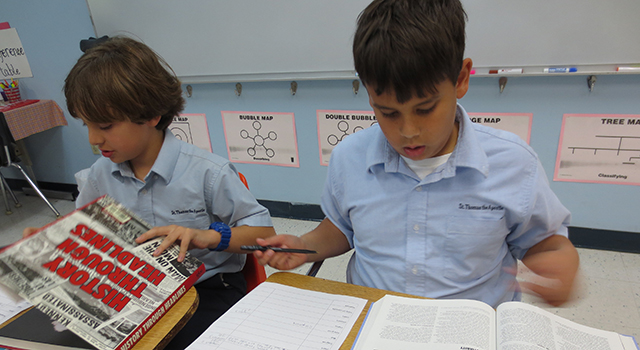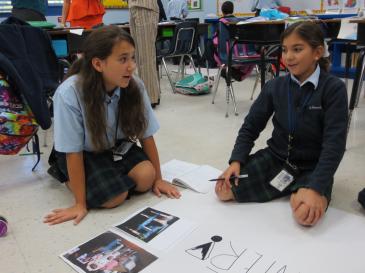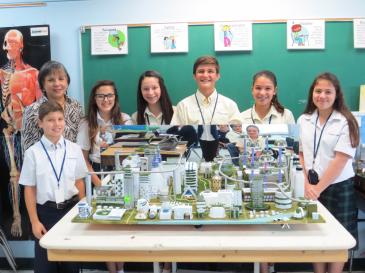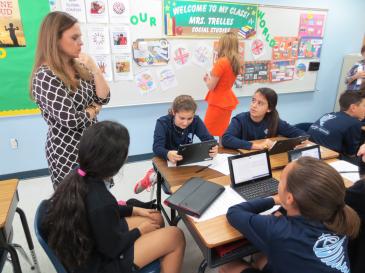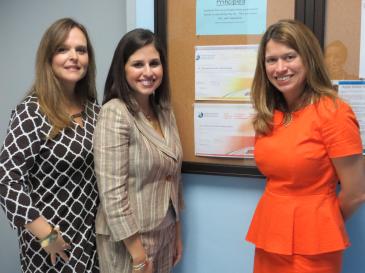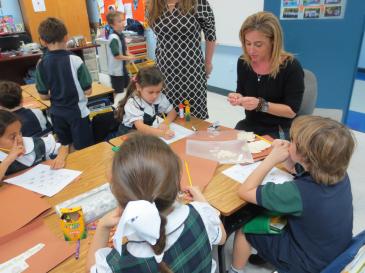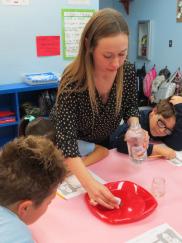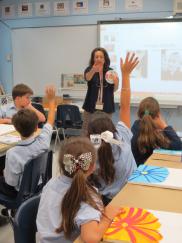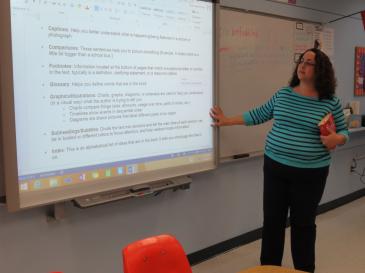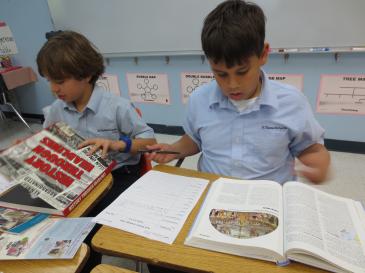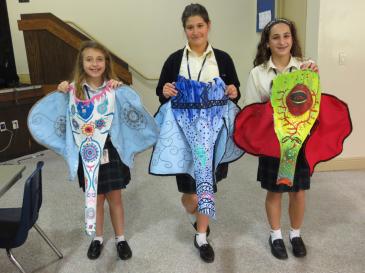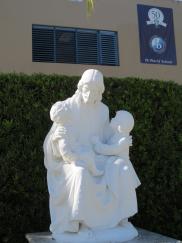By Cristina Cabrera Jarro -
Photography: CRISTINA CABRERA | FC
MIAMI | Students at St. Thomas the Apostle School in Miami are learning at a different rhythm, one set by the school’s recently-acquired status as a fully accredited International Baccalaureate World School.
Only 10 other Catholic schools in the United States are IB accredited, and St. Thomas the Apostle is the first school in the Archdiocese of Miami to receive the recognition, which came last September.
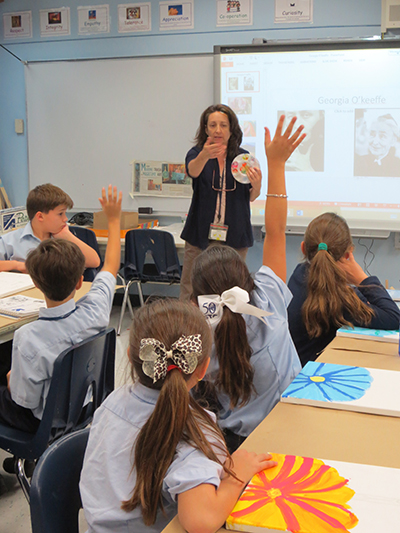
Photographer: CRISTINA CABRERA| FC
Art teacher Gigi Shaheen doesn't just hand out brushes and paint in her class. Before students can complete their work imitating Georgia O'Keefe's creations, Shaheen discusses and quizzes them on O'Keefe's style and use of color.
“It has been a three year-long process that has transformed our school,” said Annie Baixauli, IB coordinator and sixth grade science teacher at St. Thomas. “We have rewritten our policies to be more global and engaging for students. Teachers have been trained to implement a new curriculum that is more ‘hands-on’ and project based.”
The “learner’s profile” for an IB school student encompasses the following characteristics: inquirers, thinkers, communicators, courageous, knowledgeable, principled, caring, open-minded, balanced and reflective.
“Our students are the ones taking initiative,” said Lisa Figueredo, the school’s principal. “They are encouraged to achieve, and they are self-motivated and engaged. They are also learning to be global citizens.”
Founded in 1968, the International Baccalaureate is a nonprofit foundation based in Geneva, Switzerland whose educational model has reached over one million students. IB schools from all over the world share a common curriculum, allowing students to be geographically mobile, if necessary. According to theIB website, as of Dec. 11, 2014, there were 4,972 IB programs offered in 3,968 schools around the world; 61 percent were in the Americas, 23 percent in Africa, Europe and the Middle East, and 15.8 percent in Asia and the Pacific.
At St. Thomas the Apostle, families who have come from abroad have seen their children transition more smoothly into the U.S. educational system because of the international similarities. Recently, the student body has welcomed children from Canada, Brazil and Venezuela.
St. Thomas’ U.S.-born students, meanwhile, are encouraged to keep up with international news via morning announcements, the web and print publications.
With tablets and smart boards in the classrooms, inquiries can be answered within seconds. Sometimes the web results are even accompanied by pictures and videos.
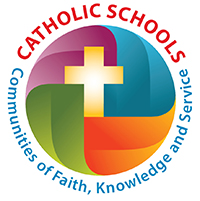
Catholic Schools Week 2015: Jan. 25-31
“The student has changed. Most of these kids are kinesthetic learners that need almost constant stimulation to remain engaged,” said Angie Ayan-Novo, assistant principal.
Engaging students from the beginning is the goal for St .Thomas’ faculty. Not only does engagement spark creativity in the students, it also allows teachers to step away from the textbooks for a while.
Maria Trelles, who teaches seventh and eighth grade social studies, has introduced her students to a documentary-making project on natural disasters. Her class will create a documentary by compiling actual footage and adding fictional interviews. The project will take about three weeks to complete, in and outside of the classroom.
“After teaching 30 years, the change was hard, but it has proven to be fun,” said Trelles. “Students with different modalities are learning.”
In Carolina Rionda’s literature and language arts class, where students are reading Walter Dean Myers’ novel “Monster,” eighth graders are writing scripts of their own imitating scenes from the book.
“In the previous unit they saw how filmmakers and their crew can control the mood for a scene by the use of shadows, lighting, and music. It is easier for a filmmaker. It is much harder for an author to create characters, suspense and pace,” said Rionda.
While the focus would appear to be solely on literature, Rionda’s course, like other classes in the school, integrates multiple subjects. With “Monster,” students are also getting a history lesson on the prejudices faced by the African American community. They are looking at letters written by Frederick Douglas as well as discussing the Michael Brown shooting in Ferguson, which happened two days before Rionda started the teaching unit.
“We plan out topics with the units, sometimes working backwards. Sometimes current events provide us with discussions we couldn’t have planned,” noted Baixauli.
Even though 40 percent of grades are based on projects, students say they enjoy the hands-on work.
“It’s fun to make and more interesting,” said fourth-grader Alexandra Belfort.
She and her classmates are working on a Florida project that calls for groups of three or four students to focus on a certain region of the state and research its tourist attractions, historical sites, and places to lodge and dine. The project not only highlights tourism in Florida, but its geography, economy and history.
Whether students are building model “green” cities for the Future City competiiton (St. Thomas has won the Florida championships five times, and placed in the top three nationally), or learning how to count in fives to tell what time it is, or even researching their favorite historical figure to imitate and quote them in a wax museum project, it is clear that education at St. Thomas is inspiring.
“There is a sense of confidence and presence that our students have developed. They have a sense of authority to want to communicate well,” said Ayan-Novo. “Our kids are excited about school and so are we.”
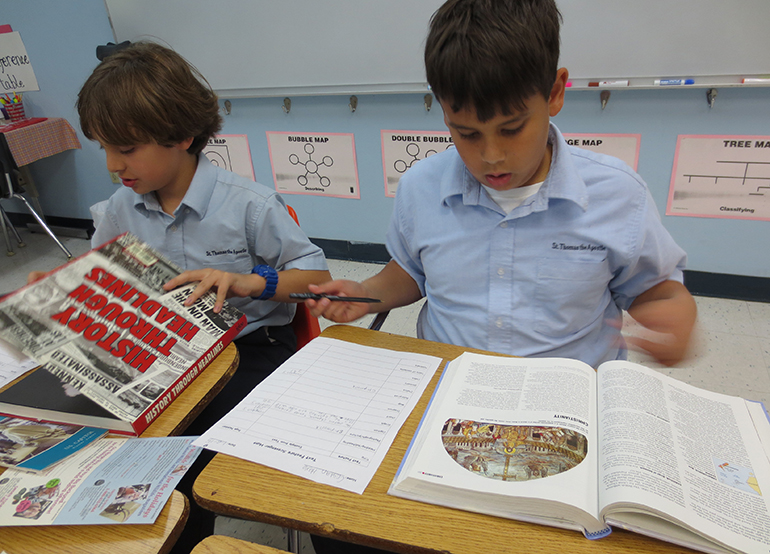
Photographer: CRISTINA CABRERA| FC
With a sense of a rush, fifth graders Cristian Hoya and Michael Merin flip through pages of various books during a research scavenger hunt. While the students have access to tablets, laptops and desktops, gifted Language Arts fifth grade teacher Lissett Navarro-Ruiz reminds them that books are still an essential part of research.
